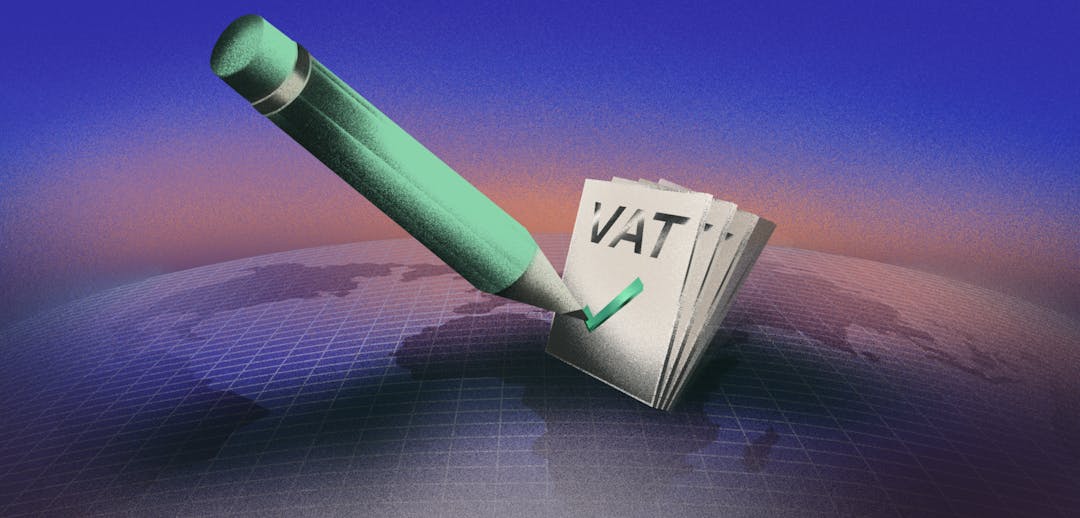Sales tax on digital goods, software, and SaaS products varies by state and country. To avoid financial and legal consequences, use this guide to stay on top of sales tax laws.
Disclaimer: The content in this article is up to date as of 1st October 2025. The below content is general information and should not be taken as legal tax advice. Please consult a tax law professional for expert advice if needed.
The most important thing to know about SaaS sales tax? There’s no standardized system across the board, which means it’s easy to slip up if you're not familiar with federal, state, and local taxes.
And trust us when we say, the last thing you want is some nasty tax penalties coming your way — we would know.
Every jurisdiction has its own guidelines when it comes to SaaS sales tax. There are some jurisdictions that have multiple tax authorities enforcing tax, meaning you must collect both state and local tax, and then pay it respectively. In some states, services are not taxable, but SaaS isn’t a traditional service and sales tax laws are liable to change.
In this guide, we explain SaaS sales tax by state and country in 2025 so you’re fully informed when selling software and products internationally.
Is SaaS subject to sales tax?
The answer to this question depends on who your customer is and where they’re located. Sales tax rules vary by country, and even by locality in some jurisdictions like the US, and your customer’s location will determine the tax rules to apply.
In 2025, more and more countries are adding software and digital products to their lists of taxable goods, and that’s down to the evolution of the industry over the past few years.
When it comes to global sales tax, the definition of a software product varies across different locations in the world. It inevitably makes managing sales tax compliance alone extremely difficult, with the cherry on top being how often these local tax regulations change.
Our all-in-one billing platform handles sales tax compliance for you, meaning we file and remit everything on your behalf so you can focus on growing your business.
The US is a great example of how complicated just one country can be when it comes to nailing your company’s sales tax obligations (let alone the rest of the countries you might be selling in). You’ve got some states that consider SaaS to be a service and some that don’t. You’ve got some states where services are taxable, and some states where services are not. And as if that wasn’t confusing enough, you’ve got some states that consider SaaS to be ‘tangible’ software, therefore making it a taxable product. And then there are all the varying tax rates and thresholds.
6 tax considerations when selling software
The lack of standardization in software sales tax categories across the world, and sometimes even across a single country, means there’s a lot to consider when it comes to selling SaaS products or services internationally.
Here are the important areas of consideration for scaling your business across borders:
- Taxable goods: what’s taxable and what’s eligible for tax exemption in specific locations
- B2B vs. B2C: B2C transactions are usually taxable depending on the territory you’re selling to. B2B is not always taxed, but in an increasing amount of jurisdictions it is. On top of that, some don’t distinguish between B2B and B2C transactions - for example, within the EU, SaaS sales tax applies to only “a VAT-registered business”. This means you could have tax obligations to people you think are businesses, but from a tax perspective, they're considered consumers.
- Economic nexus threshold and tax rate: the amount in sales you need to make before tax is due, and the amount you need to pay
- Audits: what evidence you need of taxable vs. non-taxable sales, tax payments, any relevant tax credits, and how long you need to keep records for
- Filing and remittance: how often you need to file taxes (e.g., monthly, bi-monthly, quarterly, or annually) and the method of payment — not forgetting the required currency you need to pay in
- Penalties for non-compliance: these range from backdated payments with interest to additional fines and even criminal charges, where non-compliance is thought to be malicious
If you want to offload the operational work of sales tax compliance, consider using a Merchant of Record like Paddle to take on tax liability on your behalf.
Going global with your growth strategy? Check out the updated guide on global SaaS selling
Where do you need to pay SaaS sales tax?
We wish it were as simple as, "You need to pay this amount of sales tax in this country, and this amount in this country." It is not, but we'll share some pointers to help you avoid the aforementioned hefty fines.
Here are some highlights below.
Key global tax territories
To manage sales tax successfully, you need to comply with the regulations specific to the countries or states you operate in.
Here’s a heads-up on what regulations look like across a few major territories:
The United States
Due to a lack of a blanket tax system, the US sees over 11,000 tax jurisdictions across its states, counties, and cities. With different rates in most states and even different tax treatments for various types of software and digital goods, it can get confusing quickly.
A good example of this is that in New York, electronically downloaded software and SaaS are taxable, but digital books and other digital goods are not. Whereas, in Colorado, electronically downloaded software and SaaS aren’t taxable, but digital books and other digital goods are. We’re an indecisive bunch, aren’t we?
But, how is a software product or service defined in the US? While different tax treatments apply, the jurisdictions depend on many factors, such as:
- Whether the software is delivered via a physical medium (CD or USB)
- Whether the applications or software is downloadable
- Whether the SaaS product or software is cloud-based
SaaS sales tax by state
From a tax perspective, SaaS is treated as a service (which is taxable in certain states, and is exempt in others), while downloadable software is typically treated by most states as tangible personal property and taxable via standard digital goods tax.
Here’s a break down of whether you’re liable to pay SaaS sales tax and standard digital good tax when selling into each state:
State | Do I need to pay SaaS sales tax? | Do I need to pay standard digital goods tax? |
|---|---|---|
Alabama | No | Yes |
Alaska | No (state-level), Yes (city-level) | No (state-level), Yes (city-level) |
Arizona | Yes | Yes |
Arkansas | No | No |
California | No | No |
Colorado | No (state-level), varies per local city | No (state-level), varies per local city |
Connecticut | Yes | Yes |
Delaware | No | No |
Florida | No | No |
Georgia | No | No |
Hawaii | Yes | Yes |
Idaho | No | No |
Illinois | No | Yes |
Indiana | No | Yes |
Iowa | Yes | Yes |
Kansas | No | Yes |
Kentucky | Yes | Yes |
Louisiana | Yes | Yes |
Maine | No | Yes |
Maryland | No | Yes |
Massachusetts | Yes | Yes |
Minnesota | No | Yes |
Michigan | No | Yes |
Mississippi | Yes | Yes |
Missouri | No | No |
Montana | No | No |
Nebraska | No | Yes |
Nevada | No | No |
New Hampshire | No | No |
New Jersey | No | Yes |
New Mexico | Yes | Yes |
New York | Yes | Yes |
North Carolina | No | Yes |
North Dakota | No | Yes |
Ohio | No | Yes |
Oklahoma | No | No |
Pennsylvania | Yes | Yes |
Rhode Island | Yes | Yes |
South Carolina | Yes | No |
South Dakota | Yes | Yes |
Tennessee | Yes | Yes |
Texas | Yes | Yes |
Utah | Yes | Yes |
Vermont | Yes | Yes |
Virginia | No | No |
Washington | Yes | Yes |
Washington DC | Yes | Yes |
West Virginia | Yes | Yes |
Wisconsin | No | Yes |
Wyoming | No | Yes |
From determining where you should be registered, to filing and remitting tax payments in each and every jurisdiction, managing sales tax in the US is undoubtedly a complex process. That’s why you’ll need either an in-house tax expert or the advice of a tax firm (who will charge fees for each state they examine).
European Union
Countries in the European Union (EU) apply different VAT rates to software sales. Tax on cross-border B2C digital services can be accounted for via the VAT One-Stop Shop (OSS), previously known as VAT MOSS (Mini One-Stop Shop) in 2015.
The VAT OSS system ensures that VAT is charged based on the rate of the EU country where the customer is based rather than the country where your company is based. This regulation was implemented to prevent businesses from establishing their base in a country with a low VAT rate, like Luxembourg, and applying that rate to all their EU sales.
This means that businesses must now submit a single, consolidated VAT OSS filing from their home country (or a designated EU Member State for non-EU businesses) for all relevant EU sales. This requires software companies to maintain accurate records, track all variable VAT rates across EU Member States, and collect evidence to correctly allocate sales by the customer's country for compliance purposes.
And keep in mind that all rates and regulations within the VAT OSS system are subject to change.
United Kingdom
Because of Brexit, the United Kingdom is no longer included in the VAT OSS system for sales into EU member states. That means, if you’re a UK business selling into the EU, you must register for VAT OSS in an EU member state or register for VAT in each member state your business sells digital services into.
UK VAT will still be applied to sales into the United Kingdom, although the tax filings may look slightly different. For non-registered businesses, there isn’t a threshold for sales tax which means you’re liable from your first software sale in the UK.
Rest of the world
Unfortunately, it isn’t as easy as saying, "and the rest of the world" at all. The regulatory landscape for taxing software and digital services is highly fragmented, with a number of jurisdictions worldwide establishing their own specific rules for VAT, GST, or similar consumption taxes.
Sanctioned markets to be aware of
In accordance with anti-money laundering and international regulations, there's a list of sanctioned or restricted markets that you should be aware of if you plan to sell internationally. Countries have been placed on this list for political or security reasons, so it’s more than likely these markets won’t be supported by payment providers, compliance tools, or merchants of record.
Tax systems around the world
- VAT OSS – Introduced by the European Union in 2015, VAT OSS requires you to charge sales tax where the customer is based, as opposed to where a company is headquartered or operating (has a “physical nexus”). Since 2015, a number of countries outside Europe have introduced similar regulations.
- VAT system in the Middle East – First introduced in 2018, this system covers all Gulf Cooperation Council countries (including Arab states of the Persian Gulf except Iraq). In many states in the Middle East, there is no sales threshold for non-resident businesses - meaning you have to start collecting tax from your very first sale. Over the last few years, countries like Japan, South Korea and Australia have also started requiring overseas sellers to register for sales tax.
The South Dakota vs. Wayfair Ruling – This ruling introduced the concept of “economic nexus”, meaning that Sales & Use Tax is applicable when sales into a state are above a certain threshold — regardless of where the business is based.
How to manage your SaaS sales tax compliance
There are different aspects of sales tax for SaaS companies to manage over the lifecycle of a sale. You need to consider:
- Monitoring nexus and registration obligations
- Registering when required
- Determining taxability of products/services in various jurisdictions
- Applying correct tax rate on transactions/invoices
- Reporting and paying taxes to thousands of different authorities across the globe
- Managing audits/inquiries post-sale, often years afterwards
3 ways to manage tax compliance
1. Do it in-house
Software businesses can manage their sales tax internally, but it will require a lot of time and specialist skills. It’s worth noting that if you were to take the internal tax specialist route, your company is completely liable should it be found to be non-compliant.
2. Take advantage of tax compliance tools and services
There are a number of tools available to address the 6 considerations listed above. However there aren’t many that address all of them with one tool. This route often includes multiple products, or multiple services/add-ons with one provider, to achieve a complete solution. There is typically an implementation and internal lift required as well, which can be quite time and resource consuming. And again, it’s still your company that is liable for proper tax administration if anything isn’t covered by the tools.
3. Use a Merchant of Record (MoR)
You can also employ a Merchant of Record like Paddle to handle tax compliance for your business. Your MoR will handle the headaches of payment processes and all the liability related to transactions, including sales tax compliance. A company can act as its own MoR, but the beauty of offloading tax compliance is that we take away payment and billing burdens, so you can go spend your time and resources on strategic projects and growth instead.
Did you know that the App Store is a Merchant of Record? Paddle covers the same billing issues for web payments, while putting more flexibility and control in your hands.
How Paddle helps you handle SaaS sales tax
Paddle is an MoR and provider of payments infrastructure for software companies, built to handle the back-office admin of taking payments, including full tax compliance.
Here’s more on how Paddle handles sales tax and protects companies from tax fraud and other potential penalties.
To find out more about how Paddle can help you: book a demo today.
SaaS sales tax FAQs
When is SaaS taxable?
This depends on the location and nature of the purchaser. To ensure tax compliance, it's necessary for businesses to check the local tax laws.
What is the difference between SaaS and downloadable software/digital goods?
SaaS is accessed via the internet (in a web browser or cloud platform), and the users do not own or install any application. Whereas, downloadable software is usually installed directly to the user’s device after purchase or download, and the user owns a license to use the software.
From a tax perspective, SaaS is treated as a service (which is taxable in certain states, and is exempt in others), while downloadable software is typically treated by most states as tangible personal property (and taxable in many states).
Note: This information is for general reference only. Tax rules vary by state and may change over time. For accurate and up-to-date guidance, please refer to the applicable laws and regulations in each jurisdiction.
Do countries require VAT registration from the first sale?
Yes, for non-resident businesses selling SaaS or other digital services to individual consumers (B2C), many countries and major tax blocs require immediate VAT registration from the very first sale.
For example, there is no threshold for non-EU sellers of digital services to EU consumers. There is no threshold for non-UK businesses selling digital services to UK consumers and registration with HMRC is required from the first sale. In the Middle East countries like Saudi Arabia and the UAE typically enforce a zero-threshold for non-resident sellers of B2C digital services. Other countries like Chile, Mexico, Russia, South Korea, Turkey, and Colombia also generally require registration from the first B2C digital sale by a non-resident vendor.





